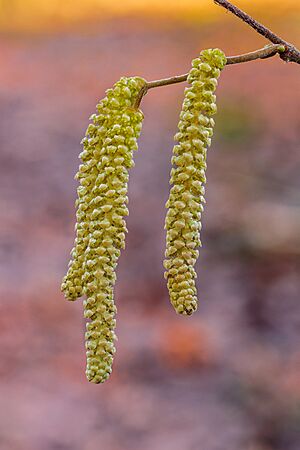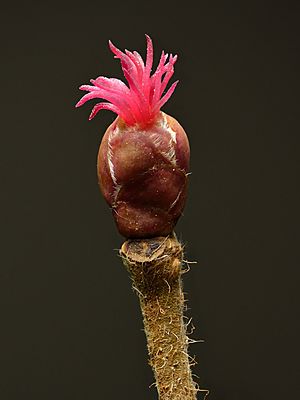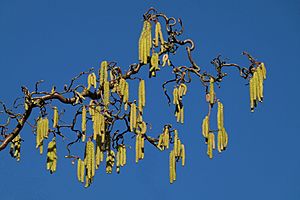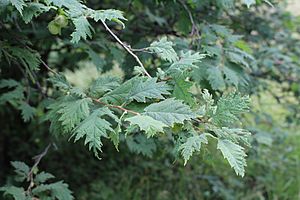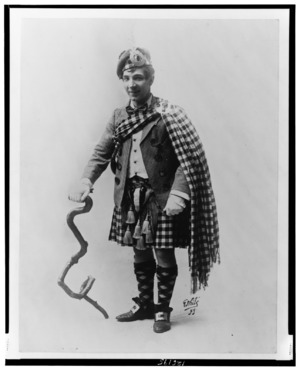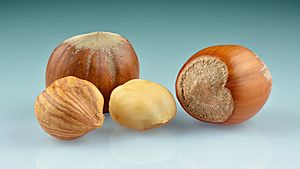Common hazel facts for kids
Quick facts for kids Common hazel |
|
|---|---|
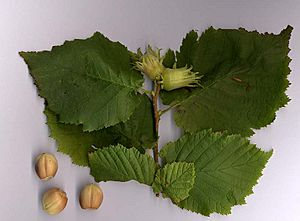 |
|
| Leaves and nuts | |
| Conservation status | |
| Scientific classification | |
| Genus: |
Corylus
|
| Species: |
avellana
|
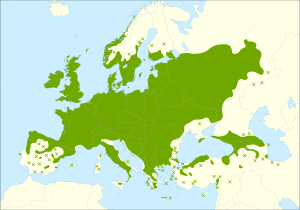 |
|
| Distribution map | |
Corylus avellana, also known as the common hazel, is a type of hazel plant. It grows naturally across Europe and western Asia. You can find it from the British Isles all the way to Spain, Greece, Turkey, and Cyprus. It also grows north into central Scandinavia and east to the Ural Mountains and Iran.
Common hazel is often seen in hedgerows, which are traditional plant fences that divide fields in places like England. People have also grown its wood for a long time using a method called coppicing. This means cutting the plant close to the ground to make new poles grow. These poles were used to build things like wattle-and-daub walls and farm fences.
The common hazel is also grown for its tasty nuts. While the name hazelnut can mean nuts from any Corylus species, in stores, a hazelnut usually comes from C. avellana. This nut, also called a cob nut, is the kernel inside a shell. You can eat it raw, roasted, or ground into a paste. Cob nuts are round, unlike the longer filbert nuts.
Contents
What Does the Common Hazel Look Like?
The common hazel usually grows as a shrub, about 3 to 8 meters tall. Sometimes, it can even reach 15 meters! Its leaves fall off in autumn (they are deciduous). They are round, about 6 to 12 centimeters long and wide. The leaves feel soft and hairy on both sides, and their edges have small, double-sawtooth shapes.
The hazel flowers appear very early in spring, even before the leaves. Each plant has both male and female flowers (this is called monoecious). The wind carries pollen between them. Male flowers are pale yellow and hang like long tassels, 5 to 12 centimeters long. These are called catkins. Female flowers are tiny and mostly hidden inside buds. You can only see their bright red styles, which are about 1 to 3 millimeters long.
The fruit of the hazel is a nut. These nuts grow in groups of one to five. Each nut sits in a short, leafy cup called an involucre or "husk." This husk covers about three-quarters of the nut. The nut itself is mostly round to oval, about 15 to 20 millimeters long and 12 to 20 millimeters wide. Some cultivated types can be larger, up to 25 millimeters long. They are yellow-brown with a pale mark at the bottom. The nut falls out of its husk when it's ripe, which happens about 7 to 8 months after the flowers are pollinated.
You can easily tell the common hazel apart from the similar filbert plant. The common hazel has a short husk that doesn't fully cover the nut. The filbert, however, has a longer, beak-like husk that completely encloses its nut.
Where Does the Name Avellana Come From?
The scientific name avellana comes from the town of Avella in Italy. The famous scientist Carl Linnaeus chose this name. He found it in a book from 1542 called De historia stirpium commentarii insignes by Leonhart Fuchs. In that book, the plant was called "Avellana nux sylvestris," which means "wild nut of Avella." This name was originally used by Pliny the Elder in his ancient encyclopedia, Naturalis Historia, written in the first century A.D.
How Hazel Helps Nature
Hazel leaves are a food source for many animals. This includes insects like the case-bearer moth, Coleophora anatipennella. Caterpillars of the concealer moth, Alabonia geoffrella, have been found living and feeding inside dead common hazel twigs. Many other Lepidoptera (moths and butterflies) also feed on hazels.
The hazel nuts are even more important as food for animals. Some invertebrates (like insects) can get past the hard shell. They often lay their eggs in the female flowers, which protects their young. Vertebrates (animals with backbones) like squirrels and corvid birds (like crows and jays) are good at cracking the nuts open. Both insects and animals that eat the nuts can be a problem for people who grow hazelnuts for a living.
Growing and Using Common Hazel
The European hazelnut is one of the most popular hazelnut plants grown for selling nuts. This shrub is very common in many forests across Europe. It's a key part of the hedgerows that have traditionally marked field borders in lowland England. The wood was often grown using coppicing, where poles were cut and used for building wattle-and-daub houses and making farm fences.
Some types of common hazel are grown just for their interesting looks in gardens. These special types are called cultivars. The Royal Horticultural Society has given an Award of Garden Merit to these two:
- 'Contorta' (also known as corkscrew hazel or Harry Lauder's walking stick, because its branches twist in a fun way).
- 'Red Majestic'
All About Hazelnuts
The hazelnut, also called a cobnut, is the nut from the hazel plant. It's usually round to oval, about 15 to 25 millimeters long and 10 to 15 millimeters wide. It has a tough outer husk that covers a smooth shell. The nut falls out of its husk when it's ripe, about seven to eight months after the flowers were pollinated.
Hazelnuts are very good for you! They have lots of protein and healthy unsaturated fat. They also contain important minerals like manganese and copper, and vitamins like vitamin E and thiamine. You can also find magnesium in them.
There are many different types of hazelnut plants, called cultivars. Some popular ones include Barcelona, Butler, Casina, and Tonda Gentile. Some are grown because their nuts are very large, or because they produce nuts early or late in the season. Others are grown to help pollinate other hazelnut plants. Most hazelnuts grown for sale are started from new shoots that grow from the roots of an existing plant. Some types are a mix of common hazel and filbert.
Common hazel is grown for its nuts in large orchards in Europe, Turkey, Iran, and the Caucasus region. The kernel inside the hazelnut is edible. You can eat it raw or roasted, or grind it into a paste. The kernel has a thin, dark brown skin. This skin can taste a bit bitter, so sometimes people remove it before cooking.
Turkey is by far the biggest producer of hazelnuts in the world, especially in the Giresun Province. Turkey produces about 625,000 tonnes of hazelnuts each year. This makes up about 75% of all the hazelnuts grown worldwide!
Images for kids
See also
 In Spanish: Avellano común para niños
In Spanish: Avellano común para niños



